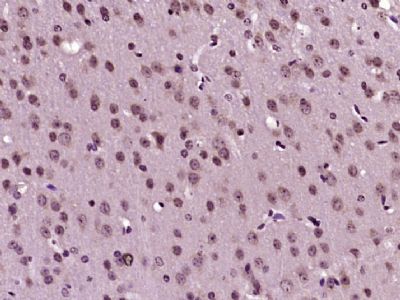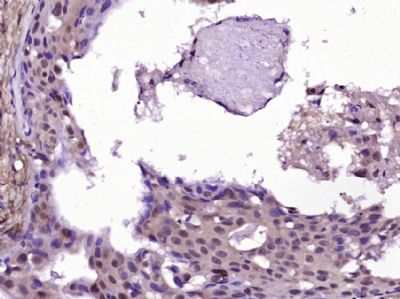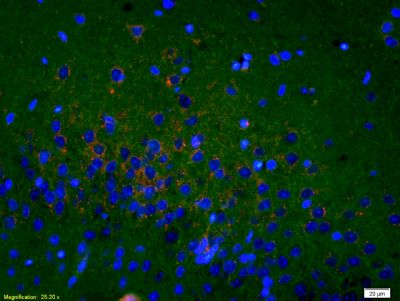产品中心
当前位置:首页>产品中心Anti-OPRS1
货号: bs-5111R 基本售价: 1380.0 元 规格: 100ul
- 规格:100ul
- 价格:1380.00元
- 规格:200ul
- 价格:2200.00元
产品信息
- 产品编号
- bs-5111R
- 英文名称
- OPRS1
- 中文名称
- 衰老相关Sigma受体蛋白抗体
- 别 名
- Sig-1R; sigma-1R; Aging associated gene 8 protein; AL024364; hSigmaR1; mSigmaR1; opioid receptor, sigma 1; opioid receptor, sigma 1 isoform 1; RP23 167I12.6; SIG 1R; sigma1 receptor; Sigma1R; SIGMAR1; SR BP; SR-BP; SR31747 binding protein; SRBP; SGMR1_HUMAN; Sigma non-opioid intracellular receptor 1; Aging-associated gene 8 protein; SR31747-binding protein; Sigma 1-type opioid receptor; SIG-1R; hSigmaR1; AAG8; SIGMAR1.
- 规格价格
- 100ul/1380元购买 200ul/2200元购买 大包装/询价
- 说 明 书
- 100ul 200ul
- 研究领域
- 肿瘤 免疫学 转录调节因子
- 抗体来源
- Rabbit
- 克隆类型
- Polyclonal
- 交叉反应
- Human, Mouse, Rat, Dog, Pig, Cow, Rabbit,
- 产品应用
- WB=1:500-2000 ELISA=1:500-1000 IHC-P=1:400-800 IHC-F=1:400-800 ICC=1:100-500 IF=1:100-500 (石蜡切片需做抗原修复)
not yet tested in other applications.
optimal dilutions/concentrations should be determined by the end user.
- 分 子 量
- 25kDa
- 细胞定位
- 细胞核 细胞浆 细胞膜
- 性 状
- Lyophilized or Liquid
- 浓 度
- 1mg/ml
- 免 疫 原
- KLH conjugated synthetic peptide derived from human OPRS1:21-120/223 <Extracellular>
- 亚 型
- IgG
- 纯化方法
- affinity purified by Protein A
- 储 存 液
- 0.01M TBS(pH7.4) with 1% BSA, 0.03% Proclin300 and 50% Glycerol.
- 保存条件
- Store at -20 °C for one year. Avoid repeated freeze/thaw cycles. The lyophilized antibody is stable at room temperature for at least one month and for greater than a year when kept at -20°C. When reconstituted in sterile pH 7.4 0.01M PBS or diluent of antibody the antibody is stable for at least two weeks at 2-4 °C.
- PubMed
- PubMed
- 产品介绍
- background:
This gene encodes a receptor protein that interacts with a variety of psychotomimetic drugs, including cocaine and amphetamines. The receptor is believed to play an important role in the cellular functions of various tissues associated with the endocrine, immune, and nervous systems. As indicated by its previous name, opioid receptor sigma 1 (OPRS1), the product of this gene was erroneously thought to function as an opioid receptor; it is now thought to be a non-opioid receptor. Mutations in this gene has been associated with juvenile amyotrophic lateral sclerosis 16. Alternative splicing of this gene results in transcript variants encoding distinct isoforms. [provided by RefSeq, Aug 2013]
Function:
Functions in lipid transport from the endoplasmic reticulum and is involved in a wide array of cellular functions probably through regulation of the biogenesis of lipid microdomains at the plasma membrane. Involved in the regulation of different receptors it plays a role in BDNF signaling and EGF signaling. Also regulates ion channels like the potassium channel and could modulate neurotransmitter release. Plays a role in calcium signaling through modulation together with ANK2 of the ITP3R-dependent calcium efflux at the endoplasmic reticulum. Plays a role in several other cell functions including proliferation, survival and death. Originally identified for its ability to bind various psychoactive drugs it is involved in learning processes, memory and mood alteration.
Subunit:
Forms a ternary complex with ANK2 and ITPR3. The complex is disrupted by agonists. Interacts with KCNA4.
Subcellular Location:
Nucleus inner membrane. Nucleus outer membrane. Endoplasmic reticulum membrane. Lipid droplet. Cell junction. Cell membrane. Cell projection, growth cone. Note=Targeted to lipid droplets, cholesterol and galactosylceramide-enriched domains of the endoplasmic reticulum. Enriched at cell-cell communication regions, growth cone and postsynaptic structures. Localization is modulated by ligand-binding.
Tissue Specificity:
Widely expressed with higher expression in liver, colon, prostate, placenta, small intestine, heart and pancreas. Expressed in the retina by retinal pigment epithelial cells.
DISEASE:
Defects in SIGMAR1 are the cause of amyotrophic lateral sclerosis type 16, juvenile (ALS16) [MIM:614373]. ALS16 is a neurodegenerative disorder affecting upper motor neurons in the brain and lower motor neurons in the brain stem and spinal cord, resulting in fatal paralysis. Sensory abnormalities are absent. The pathologic hallmarks of the disease include pallor of the corticospinal tract due to loss of motor neurons, presence of ubiquitin-positive inclusions within surviving motor neurons, and deposition of pathologic aggregates. The etiology of amyotrophic lateral sclerosis is likely to be multifactorial, involving both genetic and environmental factors. The disease is inherited in 5-10% of the cases.
Similarity:
Belongs to the ERG2 family.
SWISS:
Q99720
Gene ID:
10280
Database links:Entrez Gene: 10280Human
Entrez Gene: 538903Cow
Entrez Gene: 481587Dog
Entrez Gene: 18391Mouse
Entrez Gene: 29336Rat
Omim: 601978Human
SwissProt: Q58DH7Cow
SwissProt: Q99720Human
SwissProt: O55242Mouse
SwissProt: Q9R0C9Rat
Unigene: 522087Human
Unigene: 425181Mouse
Unigene: 1129Rat
Important Note:
This product as supplied is intended for research use only, not for use in human, therapeutic or diagnostic applications.
- 产品图片
 Paraformaldehyde-fixed, paraffin embedded (Mouse brain); Antigen retrieval by boiling in sodium citrate buffer (pH6.0) for 15min; Block endogenous peroxidase by 3% hydrogen peroxide for 20 minutes; Blocking buffer (normal goat serum) at 37°C for 30min; Antibody incubation with (OPRS1) Polyclonal Antibody, Unconjugated (bs-5111R) at 1:400 overnight at 4°C, followed by operating according to SP Kit(Rabbit) (sp-0023) instructions and DAB staining.
Paraformaldehyde-fixed, paraffin embedded (Mouse brain); Antigen retrieval by boiling in sodium citrate buffer (pH6.0) for 15min; Block endogenous peroxidase by 3% hydrogen peroxide for 20 minutes; Blocking buffer (normal goat serum) at 37°C for 30min; Antibody incubation with (OPRS1) Polyclonal Antibody, Unconjugated (bs-5111R) at 1:400 overnight at 4°C, followed by operating according to SP Kit(Rabbit) (sp-0023) instructions and DAB staining. Paraformaldehyde-fixed, paraffin embedded (Human breast cancer); Antigen retrieval by boiling in sodium citrate buffer (pH6.0) for 15min; Block endogenous peroxidase by 3% hydrogen peroxide for 20 minutes; Blocking buffer (normal goat serum) at 37°C for 30min; Antibody incubation with (OPRS1) Polyclonal Antibody, Unconjugated (bs-5111R) at 1:400 overnight at 4°C, followed by operating according to SP Kit(Rabbit) (sp-0023) instructions and DAB staining.
Paraformaldehyde-fixed, paraffin embedded (Human breast cancer); Antigen retrieval by boiling in sodium citrate buffer (pH6.0) for 15min; Block endogenous peroxidase by 3% hydrogen peroxide for 20 minutes; Blocking buffer (normal goat serum) at 37°C for 30min; Antibody incubation with (OPRS1) Polyclonal Antibody, Unconjugated (bs-5111R) at 1:400 overnight at 4°C, followed by operating according to SP Kit(Rabbit) (sp-0023) instructions and DAB staining. Tissue/cell: rat brain tissue;4% Paraformaldehyde-fixed and paraffin-embedded;
Tissue/cell: rat brain tissue;4% Paraformaldehyde-fixed and paraffin-embedded;
Antigen retrieval: citrate buffer ( 0.01M, pH 6.0 ), Boiling bathing for 15min; Blocking buffer (normal goat serum,C-0005) at 37℃ for 20 min;
Incubation: Anti-Sigma1R/OPRS1/Sigma Receptor Polyclonal Antibody, Unconjugated(bs-5111R) 1:200, overnight at 4°C; The secondary antibody was Goat Anti-Rabbit IgG, Cy3 conjugated (bs-0295G-Cy3)used at 1:200 dilution for 40 minutes at 37°C. DAPI(5ug/ml,blue,C-0033) was used to stain the cell nuclei

